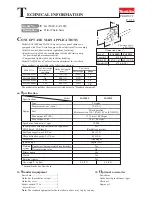
16
English
for procedures and techniques that will minimize the occurrence of
kickback.
Depth Adjustment (Fig. 7, 8)
WARNING:
To reduce the risk of injury, turn unit off and
disconnect it from power source before installing and removing
accessories, before adjusting or when making repairs.
An
accidental start-up can cause injury.
The metal cutting saw is equipped with a pivoting shoe that allows the
operator to set the depth of cut. For the most efficient cutting action,
set the depth adjustment so that one tooth of the blade projects below
the material to be cut. This distance is from the tip of the tooth to the
bottom of the gullet in front of the tooth. This keeps blade friction at a
minimum, removes metal chips from the cut, results in cooler, faster
sawing and reduces the chance of kickback.
FIG. 7
C
FIG. 8
TO SET THE DEPTH OF CUT
1. Lay the piece of material you plan to cut along the blade as shown.
2. Note how much tooth projects beyond the material.
3. Loosen the depth adjustment lever (C) and move the shoe to
change the depth of cut.
4. Retighten the depth adjustment lever securely.
Workpiece Support (Fig. 9)
CUTTING SHEETS OF METAL
Figure 9 shows the correct and incorrect way to support a large sheet.
To avoid kickback, support material near the cut. Do not support it
away from the cut. If material is supported away from the cut, it will
bind the blade and cause kickback. When cutting thin strips, keep
the blade at least 1/2" (approximately 13 mm) from the edge of the
material. Thin strips may bind, causing kickback and increasing the
risk of personal injury.
FIG. 9
1/2"
(13 mm)
CUTTING RECTANGULAR METAL STOCK
Clamp the material you plan to cut to a workbench or other work
surface as shown above.
















































